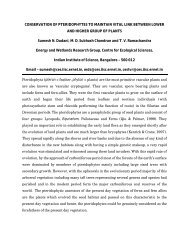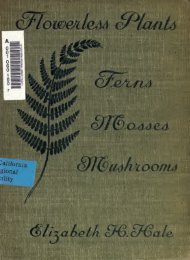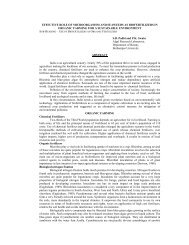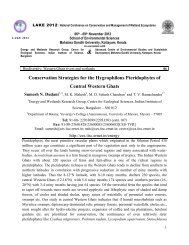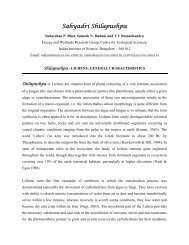regional wood energy development programme in asia ... - CES (IISc)
regional wood energy development programme in asia ... - CES (IISc)
regional wood energy development programme in asia ... - CES (IISc)
Create successful ePaper yourself
Turn your PDF publications into a flip-book with our unique Google optimized e-Paper software.
6 WOODFUEL END-USER GROUPS<br />
Woodfuels are used extensively by both the domestic and <strong>in</strong>dustrial sectors. However, there<br />
have been substantial changes <strong>in</strong> the past, due to the shift <strong>in</strong> the availability of other fuels. Before<br />
1970, when kerosene was available both <strong>in</strong> urban and rural areas, the government through the<br />
Industrial Development Corporation (IDC), <strong>in</strong>troduced the kerosene stove which was widely used<br />
because of its low cost and convenience. However, <strong>in</strong> the mid-seventies, kerosene supplies<br />
became unavailable and the kerosene stove had to be abandoned. Later, the government tried to<br />
<strong>in</strong>troduce gas stoves but, aga<strong>in</strong> because of the supply problem, the fuel could not be relied upon<br />
for daily use. At present, both domestic and cottage <strong>in</strong>dustries depend largely on biomass <strong>energy</strong>,<br />
especially <strong>wood</strong>fuel <strong>in</strong> the form of fuel<strong>wood</strong>, bamboo fuel and charcoal. In urban centres where<br />
electricity is available, electric stoves are also used. But due to the erratic electricity supply these<br />
cannot be relied upon.<br />
Many of the government departments concerned with <strong>energy</strong>, such as the <strong>in</strong>dustry,<br />
agriculture, rural <strong>development</strong>, <strong>energy</strong>, and forestry departments etc. are now tak<strong>in</strong>g a very keen<br />
<strong>in</strong>terest <strong>in</strong> <strong>in</strong>troduc<strong>in</strong>g fuel efficient biomass burn<strong>in</strong>g stoves and furnaces. However, only a limited<br />
number of these improved devices have been <strong>in</strong> actual use or made available on a commercial<br />
basis; the rest are largely still <strong>in</strong> the research and <strong>development</strong> stages.<br />
6.1 Domestic and Institutional Users<br />
Most people <strong>in</strong> rural areas still use threestone<br />
fires for cook<strong>in</strong>g. Although the thermal<br />
efficiency of these fires is low (<strong>in</strong> the order of only 10-<br />
15%) compared with the total <strong>energy</strong> delivered by the<br />
fuel, there are a number of additional benefits<br />
associated with their use: part of the heat and/or<br />
smoke emitted can be used for the preservation of<br />
food and roof structures, as a mosquito repellent,<br />
and often for warmth <strong>in</strong> colder areas. Attempts at<br />
<strong>in</strong>troduc<strong>in</strong>g improved domestic fuel<strong>wood</strong> and residue<br />
burn<strong>in</strong>g cookstoves, therefore, have been made by a<br />
number of organizations.<br />
The Forest Department through the Forest<br />
Research Institute (FRI) based <strong>in</strong> Yez<strong>in</strong> developed a<br />
fire<strong>wood</strong> sav<strong>in</strong>g stove dur<strong>in</strong>g 1986-7, locally known<br />
as "one stick stove". A number of stoves us<strong>in</strong>g this<br />
design was produced and sold on a pilot basis for 50<br />
kyats. While the fuel<strong>wood</strong> sav<strong>in</strong>g feature was amply<br />
demonstrated, the local stove producers did not<br />
desire to produce the new designs commercially due<br />
to the complicated production steps and its heavy<br />
weight.<br />
25<br />
Figure 6.1 One stick stove <strong>in</strong><br />
a kitchen of FRI worker





